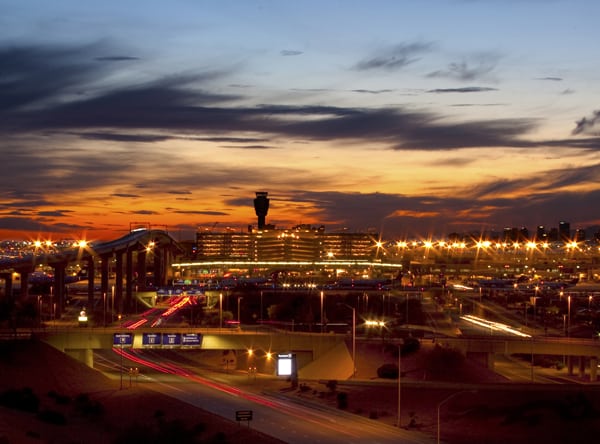[Avionics Today 06-03-2015] The City of Phoenix has announced its decision to file a lawsuit against the FAA over increased aircraft noise impacts on communities surrounding the Phoenix airport due to the implementation of Area Navigation (RNAV) flight routes over the Phoenix airspace last September. The new routes were implemented as part of the FAA’s ongoing NextGen air transportation system modernization project.

Exterior view of Phoenix Sky Harbor International Airport. Photo: Phoenix Sky Harbor International Airport.
While Phoenix has just announced the lawsuit, the agency’s unintentional consequences of increased aircraft noise resulting from the new flight paths extend well beyond Phoenix Sky Harbor International Airport. Last September, the FAA did what it has done in more than 7,000 instances to improve aircraft throughput and navigational efficiency throughout the National Airspace System (NAS): implement Performance Based Navigation (PBN) flight procedures that allow airspace users to access the more advanced capabilities of onboard modern navigation technology to save fuel and reduce carbon emissions by navigating using performance standards. According to the FAA, PBN is comprised of RNAV, which enables aircraft to fly any desired flight path within the coverage of ground- or space-based navigation aids; as well as Required Navigation Performance (RNP), which is RNAV with the addition of an onboard performance monitoring and alerting capability.
Since the implementation of the new PBN flight paths and procedures in Phoenix, the city’s mayor and several members of Congress from Arizona have written letters and held meetings with FAA staff to address complaints regarding the increased noise from citizens living near the airport. Last week, the city of Phoenix met with the FAA and several airlines to discuss the noise concerns related to the new procedures. FAA Regional Administrator – Western-Pacific Region Glen Martin sent a letter to the city manager of Phoenix stating that the agency is supportive of several short-term options that were discussed. The options outlined by Martin include “restricting early turns for northbound departures” and “supporting the city’s request to proceed with voluntary nighttime noise abatement procedures.” On Monday, the Phoenix city manager sent a letter to the FAA noting its intention to file a petition for judicial review of the implementation of RNAV routes in the Phoenix airspace.
“FAA’s RNAV route changes have exposed tens of thousands of Phoenix residents to intolerable levels of noise that affect sleep, conversation and daily life,” the letter sates. “Since the new flight paths were implemented, the city has asked the FAA for meaningful relief from the effects of RNAV to no avail. Using the FAA’s own data, the city has shown that modest modifications to the newly imposed flight tracks can reduce the number of residents affected by the loudest noise by almost half, while retaining 80 percent of the fuel and efficiency benefits of the FAA’s route package.”
The letter goes on to state that the city is seeing a “similar pattern occurring with the FAA’s Metroplex implementation process,” and requests that the agency halt the process until it can guarantee “airport operator and community involvement.” Metroplex is a NextGen initiative where the agency improves regional air traffic flows by optimizing airspace and procedures using satellite-based navigation around some of the nation’s busiest airport systems. The FAA has identified 21 metroplexes where it plans to take a system of airports with shared regional airspace and realign conventional routes and shift airspace boundaries to increase airspace throughput.
But the agency is already facing similar backlash from citizens living in neighborhoods at other airports that have seen new flight paths introduced similar to the ones in Phoenix. For example, in March, the city of Chicago received 35,000 noise complaints following the introduction of NextGen flight paths at Chicago O’Hare International Airport. In New York, Rep. Steve Israel announced the installation of an airplane noise monitor in East Hills, N.Y. to measure increased airplane noise at John F. Kennedy Airport that he has been asking the FAA to address for several years. Later this month, the Arlington County Board of Arlington, Va., is hosting a community meeting with the FAA and Metro Washington Aviation Administration (MWAA) to address complaints from residents about increased aircraft noise at Reagan National Airport, which was one of the airports within the redesigned Washington D.C. Metroplex completed late last year.
While the FAA has not responded to the lawsuit being filed against it by the city of Phoenix, the agency did recently announce its plan to address residential complaints about increased aircraft noise resulting from new NextGen flight paths. In May, the FAA also announced plans to survey public perceptions of aviation noise, as well as to “update the scientific evidence on the relationship between aircraft noise exposure and its effects on communities around airports.” The agency expects to finish gathering data by the end of 2016.